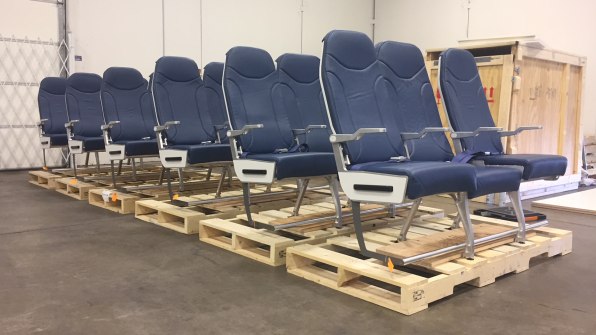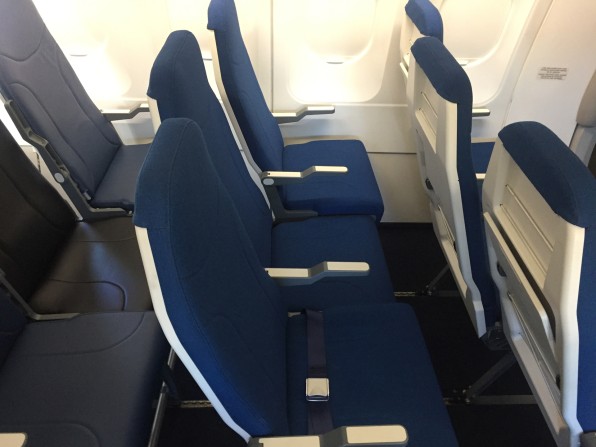How To Fix Leather Chair Seat
"There's no justice in air travel," an airline industry insider once told me. A third of passengers on planes get stuck with a middle seat, getting smushed for hours at a time in a chair that costs exactly the same ticket price as a window or aisle. That just stinks.
But what if we could rethink the middle seat to be more comfortable? In 2017, we wrote about a landmark airplane seat called the S1. Its design is unique in that it staggers the typical three-seat arrangement, so that middle-seat passengers sit slightly behind others in their row. Last month, the S1 received FAA approval to be installed on planes; an undisclosed U.S .airline will be putting them on 50 planes by the end of 2020.

The S1 has been in development for five years, and the team behind it at Molon Labe Seating is a mere six people, including sales and operations staff. Designed for commuter flights of only a few hours max, the S1 moves the middle seat a few inches lower than, and back from, the aisle and window seat. It also widens the seat by about three inches. This allows your arms, shoulders, thighs, and elbows to spread just a bit more than they otherwise could, without giving the seat more legroom or reducing a plane's seating capacity (which translates to profit margins for airlines).
"We have discovered that what looks like a small stagger actually makes a huge difference. The trick is to actually sit in the seat. In fact our main sales tool is to ship seats to airlines so they can sit in them," says Molon Labe founder Hank Scott. "I have watched this several times—airline executives see the seat, nod their head and then say they get it. Then we ask them to actually sit down, next to a big fella like our head sales guy Thomas [6-foot-6, 250 pounds]. Within a few seconds they [really] get it—they stop being an airline executive and switch into passenger modes."

The seat pairs this staggering effect with a two-level armrest design to eliminate the inevitable elbow fights that happen when six arms battle over four armrests. This approach works better in visuals than explained, but basically, the aisle and window passengers end up using the front ledge of the rest, and the middle passenger uses the rear portion.
As for the S1's final design, it is missing one big feature that we'd reported on before. Molon Labe developed a "Side-Slip" technology that actually slides the aisle seat over the middle seat for loading and unloading the plane, in order to widen the aisle so passengers could get on and off quicker. Despite successful crash tests and durability trials, the company opted to make it optional rather than a standard part of the design.
"We decided two years ago to focus on getting the S1 flying as it is . . . then once an airline is flying and happy with our seats and support, we will offer to upsell some Side-Slip Seats," says Scott. "It's such a risk-averse industry that it made more sense to offer a nonmoving seat to start with."
Aside from the S1, the company is working on similarly staggered S2 and S3 models, which are built for long-haul flights and could be out in the coming years. With any luck, the approach is as comfortable as it sounds. And while there will still be no justice in flying, at least getting stuck with a middle seat can stink a little bit less.
How To Fix Leather Chair Seat
Source: https://www.fastcompany.com/90377949/airlines-are-finally-fixing-the-middle-seat
Posted by: calhoundigh1971.blogspot.com

0 Response to "How To Fix Leather Chair Seat"
Post a Comment